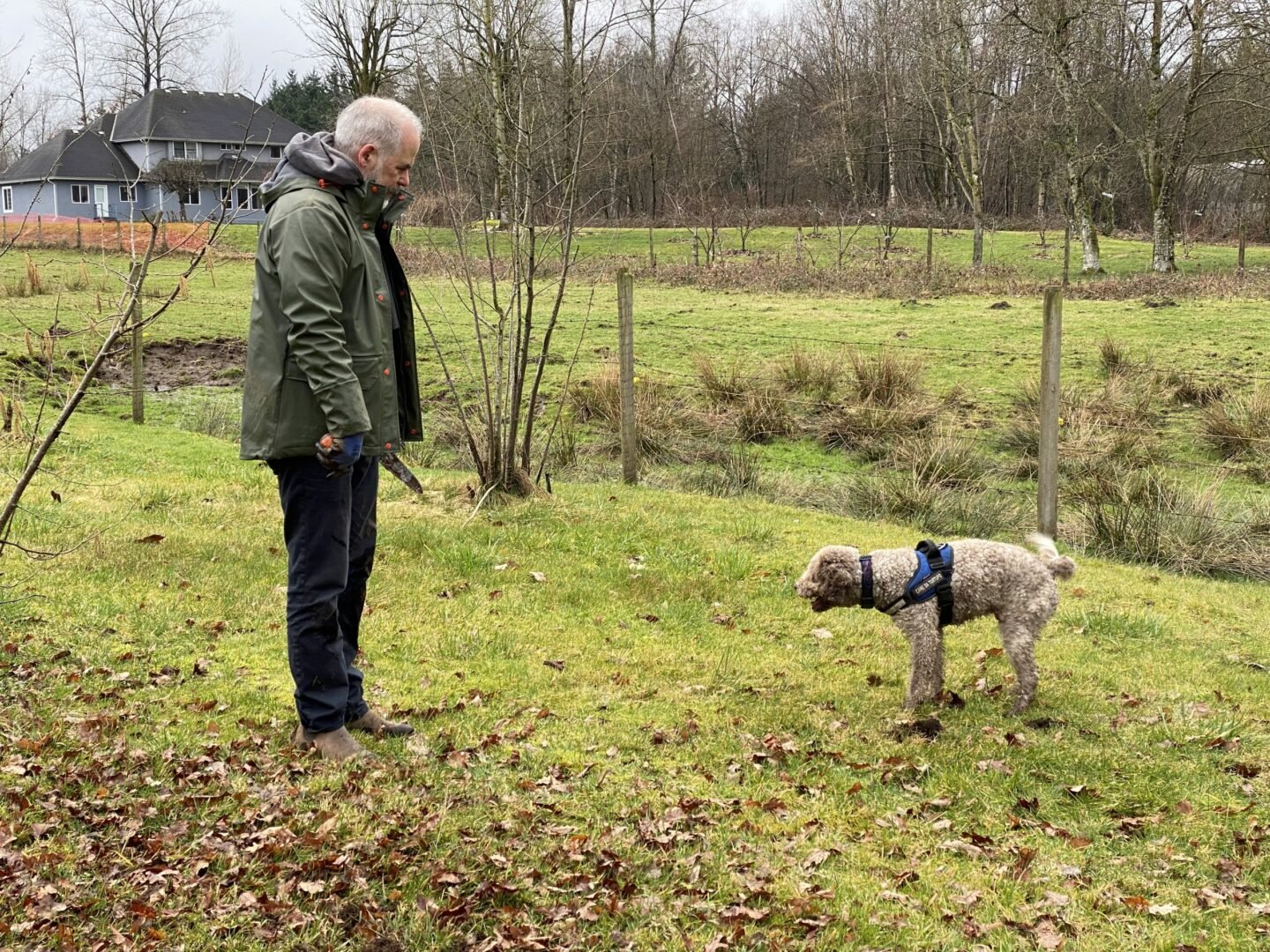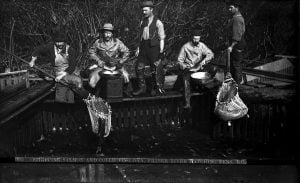
People & Culture
Renaming places: how Canada is reexamining the map
The history behind the Dundas name change and how Canadians are reckoning with place name changes across the country — from streets to provinces
- 4574 words
- 19 minutes
Travel
How British Columbia’s truffle industry is burgeoning both below and above ground — with a little help from some four-legged friends

A low grey cloud obscures the view of neat rows of oak and hazelnut trees on a farm in a remote corner of Langley. Here, in British Columbia’s agrarian Fraser Valley, the fragrances of farm life mix with that of damp earth, which is yet to show signs of new spring growth.
One scent eludes our human detection, registered only by the dogs running around us in a state of excitement. With a unique ability to smell the hidden treasure beneath our feet, the dogs are on the hunt — for truffles.
The highly sought-after delicacy is native to the Mediterranean region, particularly Italy and France. Full of savoury umami flavour, shavings of the luxurious tuber elevate dishes ranging from pasta to risotto to glammed-up scrambled eggs.
Truffles are the underground fruiting bodies of certain ectomycorrhizal fungi. Of the thousands of species of truffles worldwide, only a handful are actually fit for culinary use. Their scarcity can drive up the price to thousands of dollars per kilogram, making their cultivation an enticing prospect.
North America’s Pacific Northwest region, including British Columbia, is fertile territory for the cultivation of much of this continent’s truffle harvest. Three species of Mediterranean truffle — Tuber melanosporum (Périgord black truffle), Tuber aestivum (burgundy truffle) and Tuber borchii (bianchetto truffle) — are grown on select farms, providing a small but reliable supply of locally grown fresh truffles. But, the key to any successful truffle harvest, here, is a well-trained truffle hunting dog.

John Kelly is a tall, pipe-smoking Vancouverite, whose truffle hunting pursuits started with a love for mushroom foraging — and the search for something fun to do with his dog, Macchi. A lagotto romagnolo, the Italian dog breed specifically bred for hunting truffles, eight-year-old Macchi (short for Macchiato) was eager to learn, and proved particularly adept at hunting for truffles — both in the wild (he’s found four edible wild truffle varieties) and on cultivated truffle orchards. Macchi’s prime motivator, though, is play, rather than food. After sniffing out a truffle and pawing the earth, he waits intently for Kelly to toss the special orange “only for truffling” ball.
Lagottos, along with other truffle-proficient dog breeds, use their trained sense of smell to discover mature truffles via complex odour profiles, which can range from garlic to damp earth, pineapple or rubber tire. The scents sharpen as the truffles warm after extraction from the cool earth.
The dogs follow their noses, finding truffles in the ground via scent — only aromatic when the truffle is mature and ripe. The truffle’s life cycle depends on being found, dug up and consumed; the very act of discovery allows its spores to spread. Wild animals like squirrels, mice and deer eat the truffles outright; trained dogs mark the ground with a swipe of a paw, then wait for their reward.
For truffle hunter Brooke Page’s six-year-old puggle (a cross between a pug and beagle), Denver, that reward comes in the form of a savoury charcuterie morsel. Denver is Page’s second truffle hunting dog; her original companion Dexter was also a puggle, and a legend in his time.
An early B.C. truffle pioneer, Page started training Dexter to detect truffles in 2010. Searching in the wild for the elusive Tuber oregonense, or western white truffle, Dexter was uncommonly gifted at finding them, while Page enjoyed the thrill of the hunt and getting out into nature.
“Truffle hunting is a passion for me,” says Page, who lives in B.C.’s Okanagan region. “I saw this opportunity to pioneer the tricks of the trade of truffle hunting in British Columbia because there was so little of it back then. It was uncharted territory.”
Her enthusiasm for mycology coupled with Dexter’s hunting skills helped scientists and mycologists further their research about what edible, and non-culinary, truffle species existed in British Columbia — and where they could be found.
The value of Page’s “expensive hobby” revealed itself at a presentation to the Vancouver Mycological Society by Oregon-based truffologist Charles LeFevre of New World Truffieres. LeFevre presented colour-coded maps, detailing the “before” and “after” in many areas where Dexter had located truffles, confirming that the pair was doing something important for the science of mycology in determining the extent of wild truffles present in the Pacific Northwest.

Both the thrill of the hunt and the potential to contribute to scientific understanding of native and cultivated truffle species keeps the small number of dedicated truffle hunters doggedly engaged in this unique pursuit.
“There’s nothing common about truffle hunting in British Columbia,” says Kelly, striding behind his lively lagotto through the leaf-strewn orchard. The odds of finding them are low, and hunters keep their favorite areas closely guarded secrets. “One day, Macchi might find a kilo of wild truffles; the next day, nothing.”
There’s science behind the difficult work of creating a cultivated truffle industry, notes Shannon Berch, President of the Truffle Association of B.C., and an Associate Member of Botany at the University of British Columbia. “You have to make a truffle orchard specifically; you can’t create one after the fact.”
English oak and hazelnut tree seedlings must be inoculated and colonized with truffle fungus before planting, so the fungus matures along with the tree. On an existing orchard, the native mycorrhizal fungi are already on the trees and will “kick off” any introduced truffle fungus, says Berch. After inoculation and planting, successful truffle cultivation is a waiting game impacted by soil quality, irrigation, and climate. As in many agricultural pursuits, success is never guaranteed.
That being said, though the cultivated truffle industry in B.C. is in its infancy, two farms are working to provide a more reliable supply for aficionados and local chefs. A nut farm on Vancouver Island has successfully cultivated Périgord and Burgundy black truffles, while Langley’s Below the Oaks is home to Canada’s only farm producing Bianchetto white truffles.
Owned by Trevor and Danielle Mlinaritsch, the Below the Oaks truffière includes five acres of English oak and hazelnut trees that were inoculated for Périgord truffles as well as Italian Bianchetto truffles more than 15 years ago by truffologist Lefevre.

After 10 years, only small pebbles of the Bianchetto truffles were found, but numbers have been increasing ever since. In 2021, almost three kilograms of Bianchetto truffles were harvested on the property during the season, which runs from December to mid-April.
On a grassy, riverside glen back at the farm, puggle Denver finds a large patch of tightly clustered truffles. Smiling, Page praises him effusively, offers a tasty tidbit of steak, then digs up the cache. The fragrant, cream-coloured, knobby shapes are carefully placed into a bag, ready to be weighed at the farmhouse.
These “hound found” truffles, which fetch a wholesale selling price of $2 per gram in the current market, are sold to local chefs, restaurants and to Roots and Wings — a local distillery that created a truffle-infused vodka from Below the Oaks’ 2021 truffle crop.
It’s still early days for B.C.’s truffle industry, but its passionate proponents agree that there is potential for expanding a cultivated truffle industry, if it is done in a way that respects the land — and the animals — that allow it to thrive and grow.
In the meantime, Macchi, Denver and their human handlers will continue to keep their eyes, and noses, close to the ground, in pursuit of these diminutive and highly-prized nuggets of fragrant fungi.
Are you passionate about Canadian geography?
You can support Canadian Geographic in 3 ways:

People & Culture
The history behind the Dundas name change and how Canadians are reckoning with place name changes across the country — from streets to provinces

People & Culture
For generations, hunting, and the deep connection to the land it creates, has been a mainstay of Inuit culture. As the coastline changes rapidly—reshaping the marine landscape and jeopardizing the hunt—Inuit youth are charting ways to preserve the hunt, and their identity.

People & Culture
Depending on whom you ask, the North’s sentinel species is either on the edge of extinction or an environmental success story. An in-depth look at the complicated, contradictory and controversial science behind the sound bites

History
From their beginnings in the late 19th century, salmon hatcheries have gone from cure to band-aid to crutch. Now, we can’t live without manufactured fish.